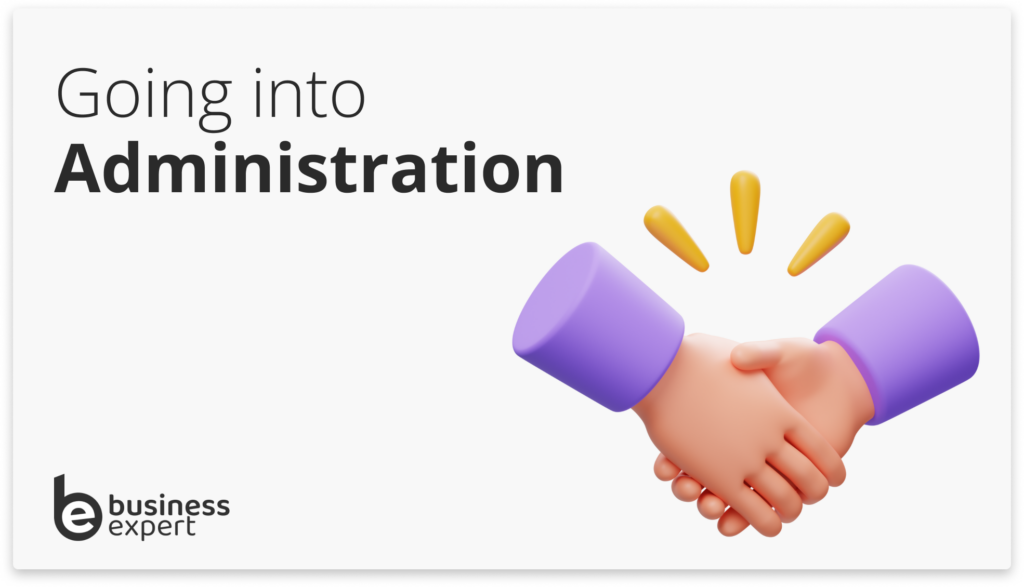We often hear that a business that’s struggling has’ gone into administration’.
We explain this common insolvency process including the process, timeframe, and implications.

Get Free Advice from Licensed Insolvency Practitioners
- If you submit this form, you’ll get a prompt response from someone who can offer advice.
- Our partners are fully licensed insolvency practitioners based in North London.
- Our recommendation is based on reviews, history, trading standards, ratings, satisfaction, trust & price.
- They offer over 100 years of combined partner experience.
- Your data will never be shared or misused.
What Does Going into Administration Mean?
When a company goes into administration, control of that business is passed to a licensed insolvency practitioner, who will act as the administrator. It is their job to explore the various options available to rescue the business, if possible, so it can repay its creditors (third parties the business owners money to) and continue to trade.
Administration is a formal insolvency process for businesses that are insolvent i.e. they cannot afford to repay their debts. Going into administration can often be the saving grace for the company. However, depending on the financial situation the business is in, it may not be in the best interests of the company’s creditors to save the business. In that case, the administrator might decide that liquidating (shutting down) the business is the best course of action.
What Happens When a Company Goes into Administration?
Once a company goes into administration, it enters what is known as a ‘moratorium’. A moratorium is a legal stay that prevents creditors from taking legal action against the company. That gives the administrators the breathing space they need to implement rescue procedures or restructure the business and return the company to profitability.
The first step for the administrator is to take stock of all the company’s assets and debts so they can understand the financial position the business is in. The administrator will have a period of eight weeks to assess the situation and decide how they want to proceed.
They’ll then send out detailed proposals to all of the creditors explaining the course of action they plan to take and the anticipated outcome. The creditors will have a meeting to decide whether they approve of the administrator’s plans. If the proposals are agreed, the administrator will be able to put their plan into action.
Who Can Put a Company Into Administration?
A company can be put into administration by its directors/owners and its secured creditors. The directors will use the administration process to try and protect the company and their position. Secured creditors might force the company into administration if they are owed money by the business and believe that, as things stand, it is not going to be repaid.
The directors of the company can appoint an administrator quickly with the guidance of their insolvency practitioner. To do this, a fax can be sent to the court with the appropriate forms. This process is very quick and does not require a court order.
Creditors must appoint an administrator via a court order. The court order mandates that the administrator must act in the best interests of the creditors as a whole and cannot favour certain creditors over others.
Why Would a Company Go Into Administration?
It’s a common misconception that any insolvent company can enter into administration – it can’t. Administration is only an option if the business is insolvent but remains viable. That is:
- It’s a reasonable size
- It generates a consistent level of cash-flow
- It has the potential to return to profitability
Although the immediate goal of the administration process is to ensure the company’s creditors receive the best possible return, it also gives the business the chance to make changes to its core operations in a bid to return to profitability. To achieve this goal, the administrator can sell assets, reduce staff and negotiate a Company Voluntary Arrangement (CVA) to repay its debts without the threat of legal action from creditors.
If a business has no assets of value, no ongoing cash-flow and no real prospect of returning to profitability, administration would not be appropriate. In that case, the only option is to liquidate the company.
How Long Does Going into Administration Take?
The process of going into administration can take anything from just a few hours to several weeks depending on your circumstances and the size of your business. Once the process has begun, it typically lasts for 12 months, although it can be extended with agreement from the courts. The business will not usually be run by the administrator for this length of time. Typically, the administrator will only be in control of the business for a period of around six weeks.
Can a Company Still Trade When it Goes into Administration?
Yes. If the administrator decides that’s in the best interests of the creditors, then a company can continue to trade during the period of administration. This is known as a ‘trading administration’, and is often used when the administrator believes the business is still viable and its recovery is likely.
If the eventual plan is for the company to be sold as a going concern, the administrator may also allow the business to continue to trade. Trading companies typically preserve more of their value. That would increase the return for the creditors when the company is sold.
What are the Potential Outcomes of Administration?
There are three potential outcomes of administration. The administrator must achieve one of these outcomes when the period of administration comes to an end:
- Rescue the company as a going concern so it can continue to trade
- Achieve a better return for the creditors than if the company had been liquidated
- Repay one or more secured or preferential creditors
To achieve one of these outcomes, there are a number of different steps the administrator can take. That includes:
- Negotiate a Company Voluntary Arrangement (CVA) so the company can continue to trade and pay its debts over time.
- Sell the business as a going concern to another company, either via a pre-pack administration or an open market sale. The business will be able to keep its clients, its workforce and order book but be free from its debts.
- Sell the business’s assets as part of a Creditors’ Voluntary Liquidation (CVL). Creditors can be paid from the money that’s raised and the business will be closed.
- Restructure the business by cutting costs, cancelling or renegotiating contracts and making employees redundant.
- Close the company if there are no assets to sell and the creditors will not receive a better return if the business continues to trade.
Is Going Into Administration the Same As Going Bust?
The technical term for going bust i.e. when a business fails and is forced to close, is liquidation. Going into administration is not the same as going bust because the administrators will always try to save the business if possible. When a company goes bust, there is no prospect of it being saved. Instead, its assets will be sold and the company will be dissolved.
What Happens If a Company Goes Into Administration and Owes You Money?
If you are owed money by a company in administration, your debt will typically fall into one of three categories. The category your debt falls into and the action the administrator decides to take will determine how your debt is treated. If the business can continue to trade, you will be repaid over time, usually via a Company Voluntary Repayment. If the business is sold as a going concern or liquidated then the following will apply:
- Secured creditors
If you are a secured creditor with a ‘fixed charge’ over an asset, the money you are owed will be secured against a physical asset such as a building, a vehicle or machinery. When that asset is sold, you will be repaid from the money raised. If you have a ‘floating charge’ over an asset, you will be repaid from the sale of that asset after preferential creditors have been repaid in full and a proportion of the money has been set aside for unsecured creditors.
- Preferential creditors
Preferential creditors are those parties that have a statutory preferential right to payment, such as employees with unpaid wages or pension contributions. Preferential creditors will receive the money they are owed ahead of all other creditors unless a secured creditor holds a fixed charge.
- Unsecured creditors
Most trade creditors such as suppliers, utility providers and landlords do not have security over an asset and are not preferential creditors. They are paid from the money generated by the sale of company assets but only after secured creditors and preferential creditors have been repaid. That means unsecured creditors often only receive a small proportion of the money they are owed.
FAQs
During administration, any remaining CBILS debt becomes a provable debt in the process, meaning it is formally recognised as part of the company’s liabilities. If the loan was under £250,000 and had no personal guarantee, it will be treated like other unsecured debts. However, for loans over £250,000 with security or a personal guarantee, lenders may call in the guarantee, making directors personally liable for up to 20% of the debt. While administration aims to rescue the business where possible, directors should prepare for lenders to enforce any security or guarantees in place.
Business recovery refers to the process of rescuing and restructuring a struggling company to restore profitability and avoid closure. Insolvency practitioners (IPs) play a key role in this, using their expertise to assess financial issues and implement recovery strategies. One of the most common business rescue methods is administration, which provides legal protection from creditors while the company is restructured. If successful, business recovery allows the company to continue trading and secure a more stable financial future, benefiting both the business and its creditors.



